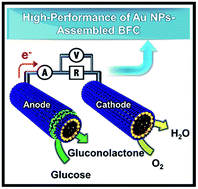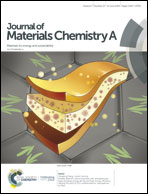Highly conductive electrocatalytic gold nanoparticle-assembled carbon fiber electrode for high-performance glucose-based biofuel cells†
Abstract
Biofuel cells, which can convert chemical energy into electricity have been considered as one of the most promising candidates for powering implantable and microscale biomedical devices. However, most biofuel cells generate a low power output, limiting their practical applications. Here, we introduce a high-performance biofuel cell based on gold nanoparticle-modified carbon nanotube hybrid fibers. These hybrid electrodes could be converted into anodes through additional enzyme deposition and used directly as cathodes, allowing notable oxygen reduction reaction activity as well as high electrical conductivity (∼6100 S cm−1). The formed hybrid biofuel cell, composed of an enzymatic anode and a gold nanoparticle-coated carbon fiber cathode, provides an outstanding stationary power output of 1.2 mW cm−2 under a fixed external resistance (cyclic voltammetry measurement ∼2.1 mW cm−2) at 300 mmol L−1 glucose. Furthermore, these one-dimensional hybrid electrodes with extremely high electrical conductivity can be widely applied in various wire-type electrochemical devices.



 Please wait while we load your content...
Please wait while we load your content...